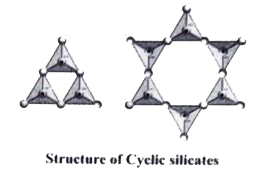Explain (i) Cyclic silicates, (ii) Ino silicates.Solution in Tamil
(i) Cyclic silicates: Silicates which contain (SiO3)2n−n ions which are formed by linking three or more tetrahedral SiO4−4 units cyclically are called cyclic sicitates. Each silicate unit shares tow of its oxygen atoms with other units.
Example Beryl [Be3Al2(SiO3)6] (an aluminosilicate with each aluminium is surrounded by 6 oxygen atoms octahedraly).

(ii) Ino silicones: Siliciates which contain n number of silicate units liked by sharing two or more oxygen atoms are called inosilicates. They are further classified as chain silicates and double chain silicates.

Chain silicates (or pyroxenes): These silicates contain [(SiO3)n]2n− ions formed by linkin n number of tetrahderal [SiO4]4− units lineary. Each silicate unit shares two of its oxygen atoms with other units.
Example: Spondumene-LiA[SIO3)2. Dougle chain silicates (or amphiboles): These silicates contains [Si4O11]6n−n ions. In these silicates there are two different typea of tetrahedra, (i) Those sharing 3 vertices (ii) those sharing only 2 vertices.
Examples, Absestos: These are are fibrous and noncombustible silicates. Therefore they are used for thermal insulation material, brake linings, construction material and filters. Asbestos being carcinogenic silicates, their applications are restricted.

Topper's Solved these Questions
- p-BLOCK ELEMENTS -IBook:FULL MARKSChapter:p-BLOCK ELEMENTS -IExercise:Additional Questions - 3-MARK QUESTIONS
Explore 26 Videos
- P - BLOCK ELEMENTS - IIBook:FULL MARKSChapter:P - BLOCK ELEMENTS - IIExercise:Additional Questions (5 Mark Questions)
Explore 11 Videos
- SAMPLE PAPER - 11 (UNSOLVED) Book:FULL MARKSChapter:SAMPLE PAPER - 11 (UNSOLVED) Exercise:PART - IV
Explore 3 Videos
Similar Questions
Write a notes on ionisation enthalpy in p-block elements?
View SolutionHow does ammonia react with
(a) Excess Cl2 (b) Na (c ) CuSO4 (d) O2/Δ
View Solution(i) How will you prepare ozone by laboratory method? Explain the structure of ozone.
(ii) Cu+,Zn2+ are diamagnetic. Prove it.
View SolutionAbout 95% of the earth's crust is composed of silicate minerals, alumino silicate clay r silica. Silicates are classified on the basis of bonding and the metal ions present in them. Some of the common categories of silicates are (I) orthosilicates , (II) pyrosilicates (III) cyclic silicates , (IV) chain silicates (V) amphiboles , (VI) sheet silicates (VII) three-dimensional network silicates Which of the following is not true regarding cyclic silicates ?
View SolutionAbout 95% of the earth's crust is composed of silicate minerals, alumino silicate clay r silica. Silicates are classified on the basis of bonding and the metal ions present in them. Some of the common categories of silicates are (I) orthosilicates , (II) pyrosilicates (III) cyclic silicates , (IV) chain silicates (V) amphiboles , (VI) sheet silicates (VII) three-dimensional network silicates What is true regarding a double chain silicate 'Amphiboles' ?
View SolutionAbout 95% of the earth's crust is composed of silicate minerals, alumino silicate clay r silica. Silicates are classified on the basis of bonding and the metal ions present in them. Some of the common categories of silicates are (I) orthosilicates , (II) pyrosilicates (III) cyclic silicates , (IV) chain silicates (V) amphiboles , (VI) sheet silicates (VII) three-dimensional network silicates Which is incorrect regarding three dimensional netwirk silicates ?
View SolutionWhich of the following have cyclic silicate structures ?
View SolutionIn which of the following silicates, only two corners per tetrahedron are shared ?
I. Pyrosilicate
II. Cyclic silicate
III Double chain silicate
IV Single chain silicate
V 3D Silicate
View SolutionIdentify the cyclic silicate ion given in the figure below
View SolutionAssertion: Cyclic silicates and chain silicates have the same general molecular formula. Reason: In cyclic silicates, three corners of each SiC_(4) tetradedron are shared while in chain silicates only two are shared with other tetrahedra.
View SolutionThe general formula of cyclic or ring silicates is
View SolutionMatch the following
(i)Orthosilicate (a)Thortveitite
(ii)Pyrosilicate (b)Beryl
(iii)Cyclicsilicate (c)Quartz
(iv)Tecto silicate (x)Phenacite
View SolutionWrite a notes on
(i) Sheet silicates (ii) Three dimensional silicate
View SolutionDraw the structure of cyclic silicate.
View SolutionGive examples of cyclic silicate.
View Solution

